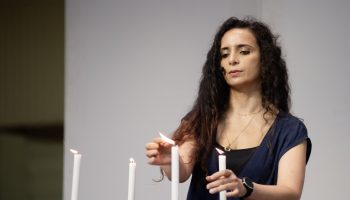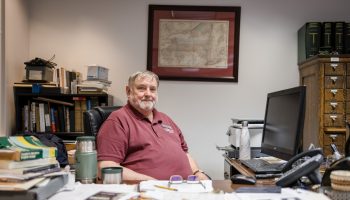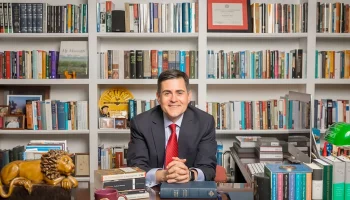
Deborah Trefts
Staff Writer
Of Earth’s seven continents, Antarctica is generally the windiest, driest and coldest, with the highest average elevation. Surrounded by the Southern Ocean, this fifth-largest continent is a rock plateau mostly covered by the Antarctic ice sheet, which has an average thickness of 1.2 miles. Its edges are rock formations.
Many people worldwide would give their eyeteeth to experience our planet’s southernmost and least-populated continent once, up close and personal, as a scientist or as a tourist.
Wildlife photographer Jeanne Wiebenga has been there three times.
At 9:15 a.m. Tuesday in the Chautauqua Women’s Club House, Wiebenga will give a presentation titled “Antarctica” as part of the CWC’s Chautauqua Speaks program.
“My third trip was in January 2024, and the other two were in the winters of 2017 and 1999 — our (Northern Hemisphere) winters,” she said. “You always go to the same place, the Antarctic Peninsula.”
“It’s a small sliver about 800 miles long, an extension of the Andes in South America,” she said. “(This mountain range) is separated from Antarctica by the 500 mile-wide Drake Passage, the most dangerous (inter-ocean passageway) in the world.”
Wiebenga said her third trip was different than her first two. Rather than traveling as one of 100 passengers, this adventure took place “on a little icebreaker” with just seven crew and 12 passengers.
“One of the benefits of being on a small ship is you can go anywhere,” she said.
Moreover, two world-class nature and wildlife photographers — National Geographic’s Frans Lanting, whose studio is in Santa Cruz, California, and Visionary Wild’s managing director, Justin Black, who is based in Washington D.C. — provided elite-level advice.
Thus, the slideshow that Wiebenga has prepared to accompany her talk is comprised of photos and videos of professional quality. This was her second trip to Antarctica with Lanting, who also provided instruction in wildlife photography during her trips to Namibia, Kenya, Botswana and the Arctic.
Having “always had the urge to travel,” Wiebenga, who was born and grew up in the Netherlands, said she flew to Israel and worked on a kibbutz two years in a row when she was 19 and 20 years old.
“We flew back to Greece and hitchhiked back to the Netherlands. It was scary … When I was 21, my parents paid for a trip to the U.S.,” she said.
It was 1969, and she was able to purchase a Greyhound bus ticket for $99 enabling her to travel for 99 days.
“I went all over with a friend and slept on the bus,” Wiebenga said. “We hitchhiked into the Grand Canyon and to Yellowstone. We stayed in a hippie colony in California (run by) David Harris, the husband of Joan Baez.”
Her travel bug and penchant for taking photos came from her father’s side of the family. Wiebenga said that her paternal grandmother “was quite well known in her time” for her Boer War and wildlife photography. “There’s a massive collection of her photographs in Pretoria, South Africa.”
After fleeing the country — on the same train as Winston Churchill — her grandparents moved to Indonesia. She said that her father was born there in 1908, and that after his father died of cholera, he and his mother returned to the Netherlands. When he was just 15, he joined the Dutch Merchant Marines and traveled aboard commercial ships until he was 21.
Wiebenga, who retired as an OB-GYN physician in 2019, earned her medical degree at Leiden University Faculty of Medicine and “always wanted to work in Africa.”
In an interview with The Chautauquan Daily in August 2017, she said that three years of rotating internships — in medicine, OB-GYN, surgery and pediatrics — prepared her for practicing in the country of her choice as part of a Dutch government program that sponsored physicians in Africa.
A friend who was working at Holy Family Hospital in Berekum, Ghana, on the west coast of central Africa, told her about the “wonderful medical director” there, who was also a “great teacher,” and she chose Ghana. Later, this teacher would become her long-term partner and fellow traveler.
Seeing a need for maternal healthcare in Ghana and in Africa more generally, Wiebenga decided to become an OB-GYN. She first earned a master’s in public health at Harvard University before completing a four-year residency in obstetrics and gynecology at University at Buffalo.
In Suriname — at the time a Dutch colony — for a six month OB-GYN rotation, she said she rowed in dugout canoes to the Amazon and slept in hammocks.
After returning to the Netherlands, the Dutch government asked Wiebenga to go to Malawi, in southeast Africa, to work as a senior OB-GYN doctor.
When she received her green card in 1992 and was able to live and work permanently in the United States, she settled in the Chautauqua area, joining Lane Women’s Health Group, a private practice in Jamestown, where she practiced for 10 years.
During the following 17 years, Wiebenga continued providing OB-GYN medical care to underserved populations.
In the United States, she has practiced in Arizona with the Indian Health Service and Navajo Nation, in northern Virginia at two hospitals serving South American immigrants, and intermittently between 2003 and 2008 as part of the senior OB-GYN staff at the Alaska Native Medical Center based in Anchorage.
For three months in 2003 and for nearly two years from 2006 to 2008, Wiebenga treated Aboriginal women while serving as senior OB-GYN staff at Cairns Base Hospital in Queensland, Australia.
In each of these places, she said that she also worked for one to two weeks at a time in remote outreach communities.
Médecins Sans Frontières (Doctors Without Borders) recruited her to work for several weeks as the OB-GYN at the French-run Aweil State Hospital Maternity in poverty stricken, war-torn northwestern South Sudan in early 2017.
From 2015 to 2019, Wiebenga practiced OB-GYN part-time at what was then known as WCA Hospital in Jamestown, New York. She said that there had been a substantial increase in unemployment since she’d been in private practice from 1992 to 2002.
Many of her WCA patients were on Medicaid. In 2017, she described their state of health as “horrendous.” It was so bad that none of her experiences elsewhere compared to it, not even South Sudan.
For many years, Wiebenga has been actively involved as a volunteer for a number of local nonprofit organizations.
At Chautauqua Institution, she’s been a member of the board of directors of the Bird, Tree & Garden Club for three years. For BTG, she said she’s “more the photographer than anything else.” Recently, she also served on the boards of the Chautauqua Golf Club and the Opera Guild.
For over six years, Wiebenga has been a board member of the Roger Tory Peterson Institute, aka RTPI.
In addition, she has been serving on the Chautauqua Watershed Conservancy’s board of directors for nearly nine years and has been co-vice president for most of them. Throughout her tenure with the Conservancy, she and Bill Locke have co-chaired its largest fundraiser, the pro-am golf tournament, each June.
Wiebenga may be best-known throughout Chautauqua County for leading the fundraising effort necessary for the Conservancy to purchase and install six platforms for nesting ospreys, as well as a camera for viewing them via its website and her own Facebook page.
“Starting up osprey photography has resulted in a massive growth of interest” in osprey, she said. “I brought (them) to people’s attention and have followed them for six years. There have been 12 fledglings. Every year, they fledge a little sooner. (This year’s) fledglings are almost fully grown.”
There have been two exhibits of her stunning osprey photography. The second was at the Athenaeum Hotel in 2022, and the first was at RTPI in Jamestown in 2021.
“Art that matters to the planet is the whole drift of RTPI now, and the 2021 osprey (show) was its first exhibit,” Wiebenga said. “The ‘Washed Ashore’ osprey sculpture (on the grounds across from the Sports Club) made it even more important to me. What a beautiful sculpture. People look at it and can’t believe it — making beautiful art out of recycling.”
At Chautauqua Speaks on Tuesday morning, Wiebenga said that she will focus mostly on the animals she’s seen and photographed in Antarctica, especially penguins, seals, whales and some bird species.




